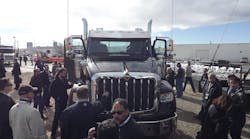LAS VEGAS. As more and more vertical design has come to the truck market – think integrated powertrains – Navistar has been embracing the concept of “open integration” in its vehicle designs. That means the option of Cummins engines. But it also means customers can choose Allison or Eaton transmissions, Dana or Meritor axles, Continental tires (standard) or some other brand.
Many OEMs also embrace this philosophy - give the customer what they want – but Navistar executives gathered here in Las Vegas believe it is a winning formula that will once again have the International nameplate back atop the vocational market share ladder.
“We want to give the customer what the customer wants,” Bill Kozek, president-truck and parts, told Fleet Owner at the launch of the company’s newest models – the HX Series of vocational trucks.
Read more: Vegas provides backdrop for International's HX Series debut
According to Jeff Sass, senior vice president of North America truck sales and marketing, Navistar’s Class 8 severe duty market share is around 17%. “We want to get over 20%,” he told Fleet Owner. “It’s really close right now [between OEMs], it ebbs and flows, and we don’t want it to be that close.”
To increase its market share, not only is Navistar focused on building quality trucks, it’s focused on providing customers options through its open integration philosophy.
“While many of our competitors go to vertical integration, we have done something different,” Sass said. “We have gone to open integration where we work seamlessly with our [partners] to integrated the leading products into our trucks.”
See the HX Series in action: International HX Series gets Vegas sendoff
Sass explained that vertical integration has some advantages, but to be a vertically integrated truck maker requires the OEM to “an expert in everything.”
“We’re taking the expertise of our [supplier] experts,” he added. “Most of the suppliers we’re partnering with have a long history in the marketplace. They have sales support teams behind them.”
Just as importantly, as Kozek noted, an owner of an International truck who has trouble with, for instance, an Cummins engine, has many options to seek service on that vehicle. They can go to their local International dealer, who can service all the components, they could seek out a Cummins dealer or they can have that engine serviced at any truck OEM dealership that services Cummins engines.
Conversely, he added, if you have a vehicle that has components from only the truck maker, there is only one option for maintenance – that truck’s dealership network.
“It’s to the customer’s benefit to have options [like that],” Sass said.



